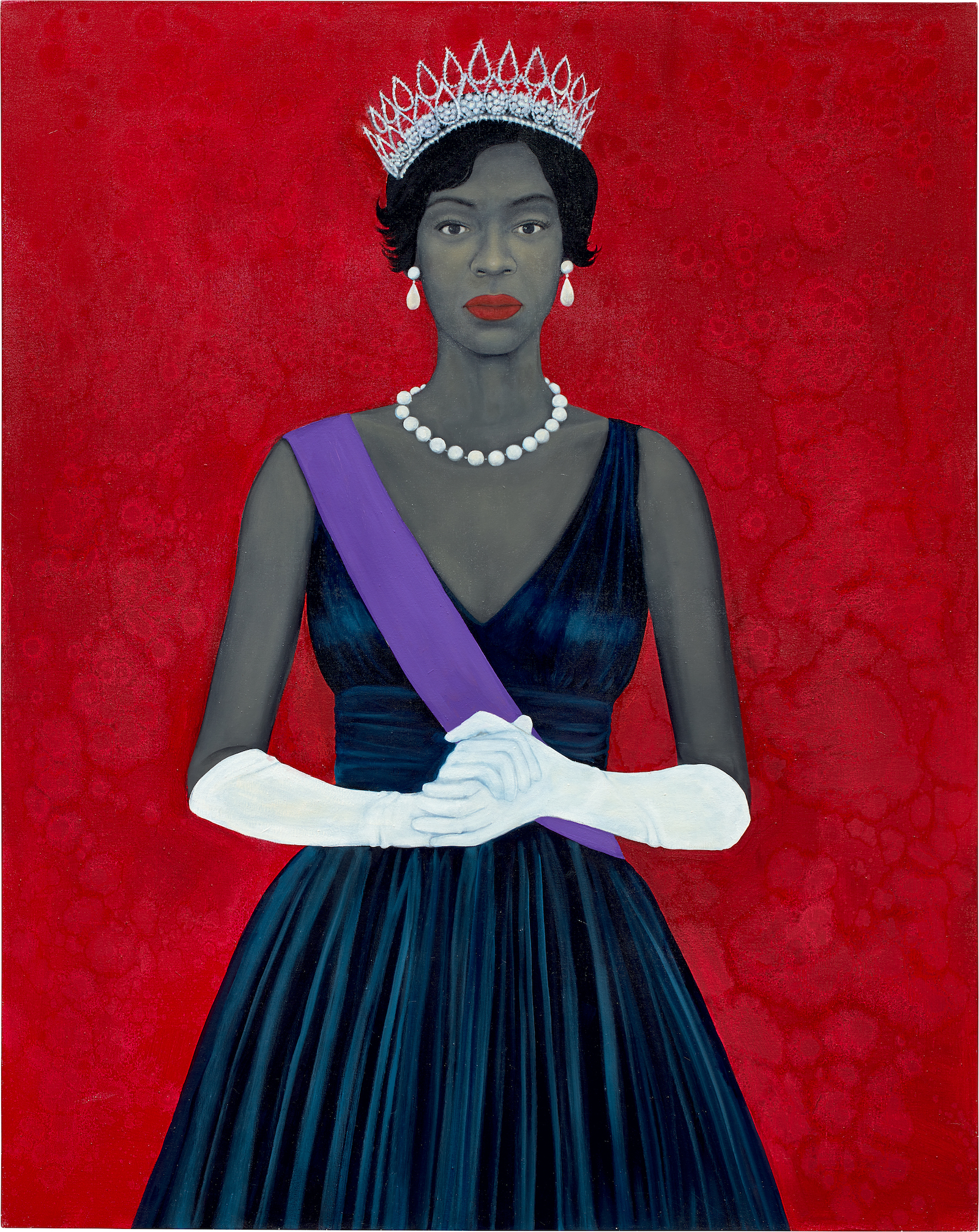
The Recent Sale of Amy Sherald’s ‘Welfare Queen’ Symbolizes the Urgent Need for Resale Royalties and Economic Equity for Artists
This past Wednesday, November 17, a regal portrait by the celebrated artist Amy Sherald sold for $3.9 million, double its $1.2 million-to-$1.8 million estimate, in the 20th-century and contemporary evening sale at Phillips New York. Welfare Queen (2012), listed in the catalogue as hailing from “a private East Coast collector,” was consigned by Dr. Imani Perry, the Hughes-Rogers Professor of African American Studies at Princeton University. In an essay for Phillips, Professor Perry recalled acquiring the work from the artist, and credited Sherald’s generosity in allowing her to use a payment plan to purchase the piece:
I was hardly in a position to begin collecting art. My budget was tight, my responsibilities to others were high. But I shyly approached Sherald about purchasing the piece over time. Her generosity was heart-warming and frankly life changing. It was the first significant piece of art I ever owned.
Sherald, however, was surprised when she learned of Perry’s intention to sell at auction. The artist wrote in a statement to Culture Type in response to the sale:
Despite its common occurrence, it can feel personal when a painting is put up for auction by a collector. Especially, in this case, when it’s someone you know and worked with to accommodate an alternative payment arrangement to acquire the piece in the first place. It is every artist’s hope that collectors will do the right thing by the work and for the artist by leveraging the gallery to assist in placing the work.
We understand from our own correspondence with Dr. Perry that she pursued alternate avenues for the sale of the work. If Wednesday’s sale followed typical auction protocol, when the gavel came down, the collector and the auction house were the direct beneficiaries financially from the multimillion-dollar sale. This case—and Sherald’s larger story—is emblematic of a larger systemic problem that has long been affecting artists. In the U.S., there are no federal laws governing resale royalties for artists, nor was there a private contract attached to the work through which royalties could be secured. This is not the first time Sherald’s work dramatically outperformed an auction house’s estimate; in December 2020, her painting The Bathers (2015) fetched more than $4 million against a $200,000 high estimate—already far more than the work’s initial price just a handful of years prior.
Given Sherald’s position as an artist and a Black woman and, uniquely, as the portraitist of First Lady Michelle Obama, we believe her story has something larger to tell us about equity, access to the arts, and the ethics of care. The connection emerges when we consider both the symbolic and economic life of Welfare Queen. The work is named after the pejorative “welfare queens,” Black women—as depicted in the 1974 film Claudine and weaponized politically in the Reagan era—accused of exploiting public benefits.
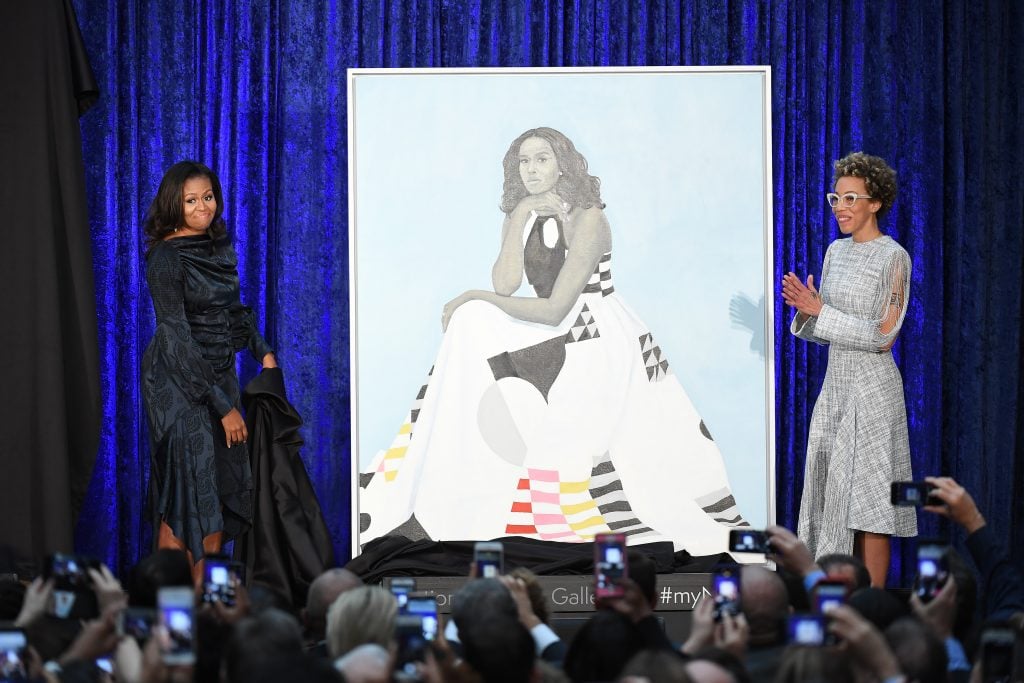
Former First Lady Michelle Obama and Amy Sherald unveil Mrs. Obama’s portrait at the Smithsonian National Portrait Gallery. (Photo by Matt McClain/The Washington Post via Getty Images)
Sherald depicts her subject in tiara and pearls, her purple sash and black dress against an absorbing scarlet background—the figure of what Dr. Perry calls “an embodiment of Black Southern defiant dignity.” Welfare Queen is consistent with Sherald’s aim of creating space to reimagine cultural archetypes and economic systems beyond structural racism. Systems of resale royalties—and equity for artists in the financial sense—embody the democratic values of community and intergenerational collaboration that have surrounded Sherald’s work.
We believe that locating lasting forms of care and mutual support in the arts represents meaningful—not merely symbolic, but structural—change for the arts ecosystem.
“Welfare” For Artists
Critics have described resale royalties—a percentage of secondary market sales returned to the artist—as “welfare” for artists. As the political scientist Theodore Marmor writes, in America, journalists used to employ a more collective language for “welfare”—what in the 1930s was called “social insurance.” Of course, those New Deal-era programs were envisioned for a white America; by the 1960s, proposals from artists and others were imagining more inclusive systems of collective welfare and distribution. Among artists, these included models that would go beyond individual benefit, such as the Siegelaub-Projansky Agreement made famous for its resale royalty clause, and which instead redistributed art market profits more broadly.
Systems of artists’ royalties—whether paid to artists individually or shared across groups—are increasingly common across NFT platforms and are already implemented in U.S. organizations through initiatives such as the Resale Royalty Award Program (RRAP) at the Souls Grown Deep Foundation. These initiatives allow artists to continue to profit from their own work and also to share proceeds across each other’s work. This potential to benefit individually and collectively—to rediscover social insurance and risk-sharing—could transform economic sustainability in the arts and help us reimagine the democratic ideals and invitation that Sherald’s own artistic trajectory has embodied.
The year that Sherald painted Welfare Queen, as the artist recently told Elaine Welteroth in conversation at LACMA, she also received a transplanted heart. Four years later, she was four months behind in rent and borrowed gas money to make it to the reception for the National Portrait Gallery’s Outwin Boochever Portrait Competition. Sherald made history as the first Black woman to be awarded first prize.
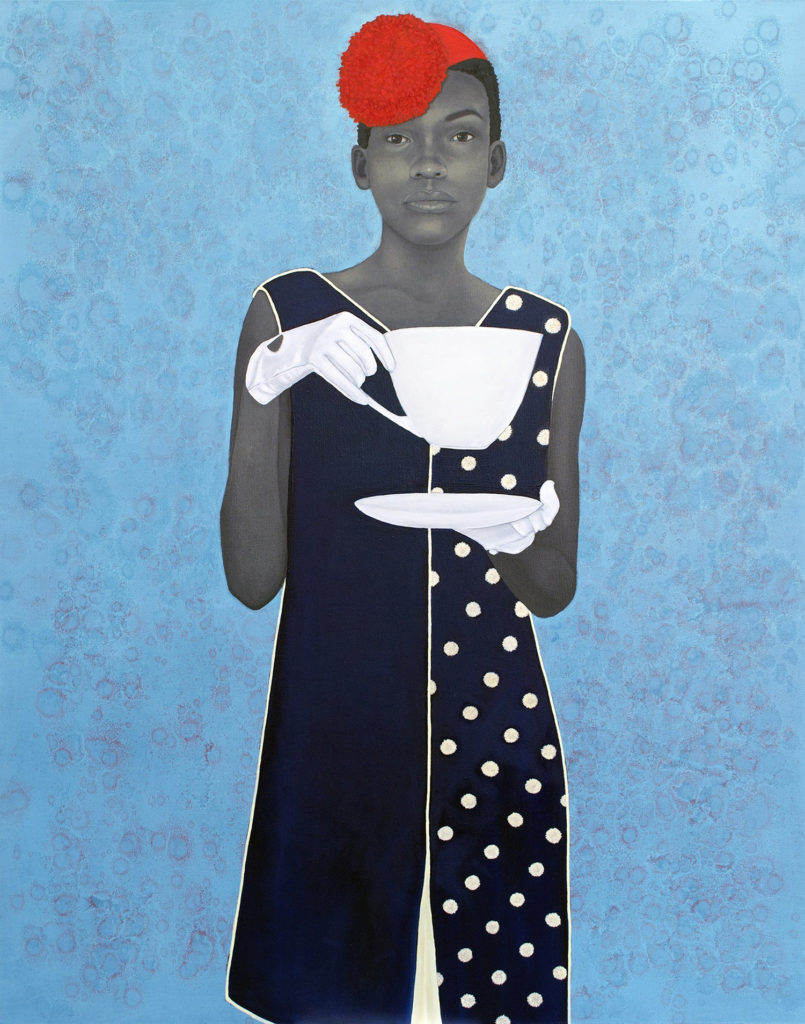
Amy Sherald, Miss Everything (Unsuppressed Deliverance), 2014. Courtesy of the artist and Hauser & Wirth, ©Amy Sherald.
Her piece, entitled Miss Everything (Unsuppressed Deliverance), reflects the wholeness of Black American life, and like each of Sherald’s works, inspires conversations around representation, equality, and democracy. Her winning portrait was instrumental in drawing the attention of the selection committee that would commission Sherald for First Lady Michelle Obama’s portrait.
Neither the artist, nor Mrs. Obama, nor the curators could have foreseen the impact Sherald’s iconic portrait would have. From the unveiling of the Obama portraits in 2018 to 2020, 4 million people visited the National Portrait Gallery, doubling its attendance and transforming the makeup of its audience. And the paintings continue to welcome in new audiences to many other institutions, as the works are now on tour. In this way, the Obama portraits also illustrate a kind of public engagement with art that comes much closer to public museums’ ideal role in a vibrant democracy.
Sherald’s economic status before her commission for Mrs. Obama’s portrait is important, too, as it mirrors the origins of so many artists. Many celebrated contemporary artists have juggled minimum-wage day jobs, sporadic income, and the burdens of life while managing to keep making art. Crucially, Sherald’s is not a simple rags-to-riches tale, but one that illuminates a network of support, from gas money to grants and ultimately to a life-altering commission.
As Sherald herself has said, “Being an artist is not easy, it’s feast or famine….” This is partly because artists make work before its value is legible, and often watch from the sidelines as collectors receive the full upside of secondary sales—a financial gain that is fueled, in part, by the artists’ continued career trajectories. Resale royalties are intended to address the problem of value over time, with artists receiving a share of the upside when works resell.
From Resale Royalties to Resale Equity
Over 70 jurisdictions worldwide have mandated resale royalties, including the European Union and the United Kingdom. In 2018, DACS, the U.K. agency that collects the Artist’s Resale Right, distributed £18 million ($24.1 million) to individual artists, while the Arts Council England’s grants to artists totaled £12 million ($16 million).
In a study of resale royalties on the NFT platform SuperRare, Massimo Franceschet and Sparrow Read consider how the share claimed by artists and collectors changes over time. In a survey, DACS found that 81 percent of artists who received resale royalties spent the income to cover living expenses, 73 percent used royalties for art materials, and 63 percent for studio space.

Kevin McCoy, Quantum Image courtesy Sotheby’s.
In fact, there are many bright spots and equity efforts happening in the resale-royalty space, some enabled by blockchain technology and some occurring in the same day-to-day human relationships as the one in which Professor Perry first purchased Welfare Queen.
When the artist Kevin McCoy sold the first-ever NFT, Quantum, last summer for $1.4 million, he shared some proceeds back to his longtime dealer. In her “Say It Loud” exhibition series, the curator Destinee Ross-Sutton ensures that Black artists—whose works are often flipped by speculators—are protected and supported. In the first exhibition, buyers had to sign a contract stipulating they would not sell the work for five years and, if sold after that, return 15 percent of the proceeds to the artist. In the second exhibition, 100 percent of the proceeds went to the artists and their teams. Ross-Sutton now employs similar contracts through her new gallery that ensure resale royalties for artists.
Wednesday’s auction at Phillips offered its own counterexample. Titus Kaphar’s Fade With Time (2013) sold for $750,000, accompanied by an explanation that “the seller intends to donate the sale proceeds to a charity,” specifically an “artist’s residency program.”
This model echoes the agreement developed by arts organization Kadist that allows artists to direct a portion of resale proceeds to a charitable organization of their choosing—or Robert Rauschenberg’s call, in 1988, for a portion of the resale proceeds on auction sales of his work to benefit his nonprofit Change, Inc., which helped artists pay for medical and other emergency expenses.
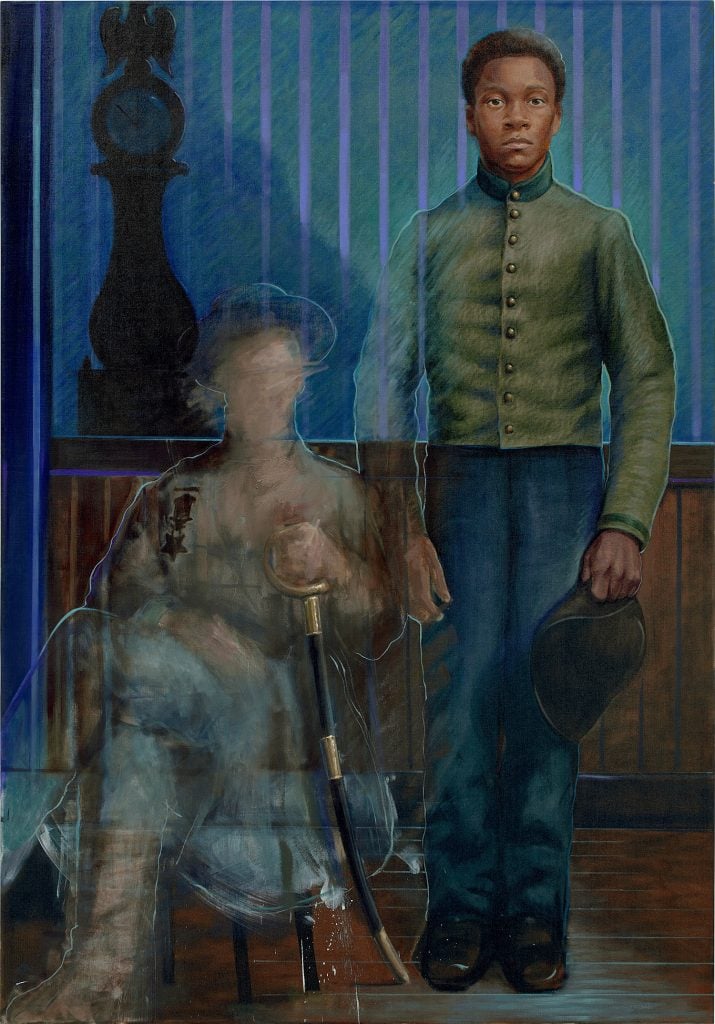
Titus Kaphar, Fade With Time (2013). Photo courtesy of Phillips.
We propose a system of “resale equity” in which works like Sherald’s Welfare Queen could go to auction with flexible and elective resale-royalty provisions. Sellers could agree to return some portion of the proceeds back to the artist, ideally via a nonprofit so that the donation is tax-deductible. Auction houses or other market intermediaries wishing to incorporate such activities into their equity practice could pledge a portion of the seller’s commission or the buyer’s premium back to the artist.
Sale participants could structure these arrangements flexibly, taking inspiration from Kadist’s work on redistributing proceeds to charity, or newer experiments by individual artists, such as Sara Ludy’s announcement that 35 percent of her sales would go to her gallery, but with 7 percent to the gallery owner and the other four 7 percent shares assigned to the gallery’s individual workers.
Artists could also band together to use these systems to share risk, pool resources, and redistribute proceeds. Models here include artists in the new media group Feral File’s exhibitions, who each receive a copy of all of the works by the other artists in the show. For the exhibition “Pieces of Me” at curator Kelani Nichole’s online gallery Transfer, 70 percent of each sale is paid to the artist of the work, while the remaining 30 percent is pooled and distributed to all of the remaining artists in the exhibition.
Elective participation in these equitable practices should not exclude legislated resale royalty systems. But returning proceeds to artists via equity systems broadly is also the kind of structural work too often left to symbolic—and thus hollow—statements of equity and inclusion that don’t address changes in leadership, gallery ownership, representation in nonprofit governance, and other seats of power in the larger arts ecosystem.
The sale and resale of Welfare Queen combine stories of economic necessity with human stories of grace and generosity. To focus on resale royalties and reconsideration of financial equity is to invite participation in the seismic shifts that can support futures of greater economic sustainability and access. Such redistributive models become even more timely to consider as modern and contemporary auctions continue to reach record prices.
Toward an Ethics of Economic Care
Perhaps no one understands the necessity of paying it forward more than artists themselves. Mark Bradford, Wangechi Mutu, and Kehinde Wiley, among others, have developed foundations, art centers, and residencies to support artists coming into the system behind them.
Sherald, too, joins the list of those distributing proceeds in creative ways. Her portrait of Breonna Taylor, commissioned by Ta-Nehisi Coates for the September 2020 issue of Vanity Fair is just one recent example.
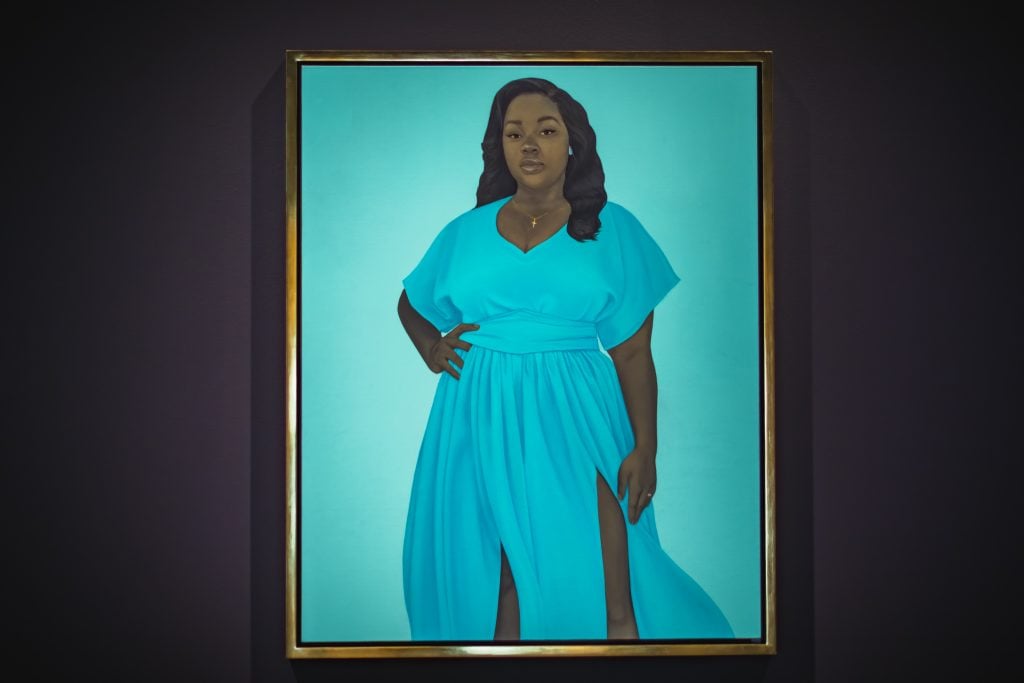
Installation view, of Amy Sherald’s portrait of Breonna Taylor in “Promise, Witness, Remembrance” at the Speed Museum. Photo: Xavier Burrell.
The moving memorial, picturing the slain EMT worker wearing an aquamarine dress, her favorite color, against a muted cerulean background, was purchased for $1 million by the Speed Museum in Louisville, Kentucky, and the National Museum of African American History and Culture in Washington, D.C.—with funds donated by Kate Capshaw and Stephen Spielberg’s Hearthland Foundation and the Ford Foundation, at the direction of Sherald.
The proceeds of the sale were used to establish a trust to support educational initiatives around social justice in Taylor’s hometown. For the art world, these systems of equity and redistribution create spaces of empowerment for artists, and can support the many more Amy Sheralds of the world.
Cheryl Finley, PhD, is Inaugural Director of the Atlanta University Center Art History + Curatorial Studies Collective and Distinguished Visiting Professor, Spelman College. On leave from Cornell University, she is author of the award-winning Committed to Memory: The Art of the Slave Ship Icon (Princeton University Press, 2018), and at work on a book on the art market, Black Art Futures.
Lauren van Haaften-Schick is a PhD Candidate in the History of Art at Cornell University, a Smithsonian Institution Predoctoral Fellow, and a Fellow at the Engelberg Center on Innovation Law and Policy at NYU Law School. She is co-editor of Seth Siegelaub: “Better Read than Dead,” Writings and Interviews 1964–2013 (Koenig Books & Stichting Egress Foundation, 2020)
Christian Reeder is a recent graduate of Spelman College and the Atlanta University Center Art History + Curatorial Studies Collective and a first-year graduate student of Visual and Critical Studies at the School of the Art Institute of Chicago. She led the winning team of the Inaugural AUC Art Collective—Sotheby’s Institute of Art Black Art Futures Innovation Challenge.
Amy Whitaker, PhD, is an Assistant Professor of Visual Arts Administration at NYU Steinhardt, a researcher on NFTs and fractional equity, and an award-winning author. Her most recently published book is Economics of Visual Art (Cambridge University Press, 2021).
Follow Artnet News on Facebook:
Want to stay ahead of the art world? Subscribe to our newsletter to get the breaking news, eye-opening interviews, and incisive critical takes that drive the conversation forward.




